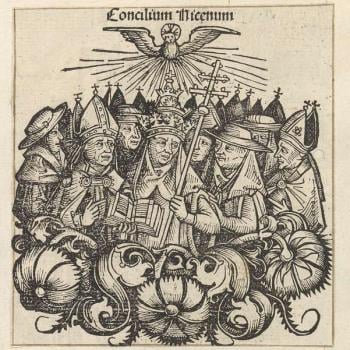Are any of you familiar with the New English Translation (NET) of the Bible?
One of my fellow Patheos bloggers, Frank Viola, blogged about it, which intrigued me. It’s a new translation that can be downloaded for free. But what makes it unique are its 60,000 notes on the translation, explaining the nuances of the original languages and why the translators chose the reading they adopted.
As you may or may not know, there are two major approaches to translation, particularly Bible translation. You can try to render the text as literally as possible in a word-for-word translation (the “formal equivalent” approach). Or you can try to translate not so much the words as the meaning of the passage (the “functional equivalent,” sometimes called the “dynamic equivalent,” approach).
Formal equivalent translations of the Bible would include the KJV, the RSV, the NASB, and the ESV. Dynamic equivalent translations would include the Living Bible, the Good News Bible, and God’s Word translation (a Lutheran project). Of course, translations exist on a continuum between these poles. The NIV attempts a balanced approach, though it leans to the dynamic equivalent side.
My own preference is for formal equivalent translations, with the understanding that different grammatical systems make perfect word-for-word renditions impossible. To say your are translating not the words but the meanings implies that you know for certain what the meanings are. Dynamic translations often end up giving the translators’ beliefs, as opposed to what the authoritative text says. The doctrine of the clarity of Scripture does not take away our need to “rightly handle the word of truth” (2 Timothy 2:15). Give the inspired words, figures of speech, and grammatical nuance and let the readers unpack them.
But I digress. . . .What the NET does is to give an easily-understood functional equivalent reading and in the notes give the formal equivalent details of what the language says. From the Wikipedia entry about the NET:
In the preface to the first edition, W. Hall Harris III, PhD, “The NET Bible Project Director” claims that the NET Bible solves the problem of dynamic vs. formal equivalence:
[T]he translators and editors used the notes to give a translation that was formally equivalent, while placing a somewhat more functionally [or dynamically] equivalent translation in the text itself to promote better readability and understandability. The longstanding tension between these two different approaches to Bible translation has thus been fundamentally solved.
The preface of the NET Bible presents the advantage of this feature in the following way: “The translators’ notes make the original languages far more accessible, allowing you to look over the translator’s shoulder at the very process of translation.”
Here is how the NET renders Matthew 26:28 in the account of the Lord’s Supper:
“for this is my blood, the blood of the covenant, that is poured out for many for the forgiveness of sins.”
Here is the translation note on that passage:
tn Grk “for this is my blood of the covenant that is poured out for many.” In order to avoid confusion about which is poured out, the translation supplies “blood” twice so that the following phrase clearly modifies “blood,” not “covenant.”
This is an important passage for us Lutherans. The NET reading makes it clear that the wine in the cup “is” Christ’s blood. Furthermore that the wine in the cup “is” the blood of the covenant and that it “is” the blood poured out for many for the forgiveness of sins. As opposed to lumping everything together into an abstraction in which the covenant is somehow poured out.
Though I appreciate that reading, after a rather brief check of some of the texts, I’m not a big fan of the NET text. Though it commendably gets rid of the ESV rendition of “rules” for certain Levitical requirements, restoring the more traditional “ordinances,” it keeps the annoying “brothers and sisters” reading of so many modern feminist-sensitive translations instead of “brothers”. I can accept the explanation that adelphoi can be shown to sometimes refer to a collection of both men and women, so why not use the traditional rendering of “brethren,” which is an older plural form of “brother,” like adelphos, but can be explained as having also an inclusive sense.
I also believe that metaphors and figures of speech in the original inspired text should be translated as such, instead of interpreted, thus flattening out the poetic quality that God too evidently inspired. Genesis 4:1 says that “Adam knew Eve his wife; and she conceived,” which is the literal Hebrew wording, as faithfully carried over in the King James Version. The NET says that “know” in this context is a sexual euphemism, which is obvious from the context, but it renders the verse to say “the man was intimate with his wife Eve,” which is just as euphemistic. If we are going to be euphemistic, which we should be, let’s use the euphemisms given in God’s Word, as the ESV does.
Overall, the NET readings, especially of the Psalms, seem rather flat and lacking resonance. Again, God inspired poetry, so the poetic qualities should be carried over as much as possible in the English translations. Says the literature professor.
But see for yourself. The NET has an excellent website that enables you to read any passage you please, with the translation notes (as well as other kinds of notes) side-by-side. Go here and play around with it, looking up your favorite passages or test cases and report on what you like or don’t like about the NET renderings.
You can also download the entire NET Bible for free. Go here. You can use it and print it and publish it for free, without permission, though if it’s a commercial venture you need to follow the easy requirements given on the copyright page. Says the editors, “The Bible is God’s gift to humanity – it should be free.”
The notes, however, are the translators’ gift to humanity, and they are only free on the website. The downloadable Bible does not include the notes. A brand new edition from Thomas Nelson, the long-time publisher of the KJV, does, however, include the notes, and Frank Viola is impressed with the edition. You can get one for just $20 here, with leather bound and other kinds of editions here.
The NET first came out in 2001, but has gone through various updates since then. According to the introduction to the NET, “The initial planning group was interdenominational and evangelical, although not made up of official representatives from church groups or denominations. A deliberate decision was made early on to devote special attention to the avoidance of doctrinal peculiarities or sectarian bias in the new translation.”
The NET is connected to Bible.org, which affirms the inerrancy of Scripture. Their doctrinal statement is here. Many of the translators and editors, listed at the end of the Introduction, are from Dallas Theological Seminary, though reviewers haven’t noticed any overt dispensationalism, though others are from major universities in the UK and elsewhere. I didn’t notice any Lutheran scholars that I knew of.
Still, I think Lutheran laypeople and, especially, pastors, even if they don’t use the NET text, would find those translation notes useful in the study, teaching, and proclamation of God’s Word.
Photo via Amazon.com














